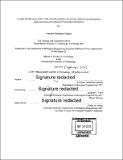| dc.contributor.advisor | Jacquin C. Niles. | en_US |
| dc.contributor.author | Nasamu, Armiyaw Sebastian | en_US |
| dc.contributor.other | Massachusetts Institute of Technology. Department of Biological Engineering. | en_US |
| dc.date.accessioned | 2016-07-18T20:02:31Z | |
| dc.date.available | 2016-07-18T20:02:31Z | |
| dc.date.copyright | 2015 | en_US |
| dc.date.issued | 2015 | en_US |
| dc.identifier.uri | http://hdl.handle.net/1721.1/103699 | |
| dc.description | Thesis: S.M., Massachusetts Institute of Technology, Department of Biological Engineering, 2015. | en_US |
| dc.description | Cataloged from PDF version of thesis. | en_US |
| dc.description | Includes bibliographical references (pages 65-67). | en_US |
| dc.description.abstract | Plasmodium falciparum is the deadliest malaria parasite. There is no approved vaccine to prevent this disease, and resistance to available antimalarial drugs is becoming widespread. Identification of parasite genes essential to survival and virulence could facilitate the development of novel therapeutics and vaccines. However, these efforts have been impeded by difficulties in manipulating the parasite's genome and functionally perturbing gene expression in a controlled way. Our lab has developed inducible systems to control P. falciparum gene expression, and has achieved successful editing of the P. falciparum genome using CRISPR/Cas9 technology. We have integrated these capabilities into a modular and scalable framework that can be used to efficiently edit, regulate and delete any target parasite gene after a single genome editing operation. This approach will accelerate studies of parasite gene function, and help prioritize potential drug and vaccine targets. A key requirement in this framework is the efficient assembly of donor vectors for modifying target loci and installing the necessary regulatory parts. This necessitates cloning several large, [A+T]-rich P.falciparum genomic regions that can be quite tedious and rate limiting. In this document, we show a new cloning strategy using linear vectors that facilitates rapid and accurate assembly of vectors capable of transforming P. falciparum. We present evidence of successful chromosomal modification of several genes via spontaneous single crossover, as well as zinc finger nuclease- and Cas9- mediated genome editing strategies using our assembled donor vectors. We also show that these modifications enable controllable expression of several previously uncharacterized genes to elicit phenotypes that we are investigating in further mechanistic detail. Importantly, these transgenic parasites can now be rapidly generated to allow identification of novel essential parasite genes in as little as a month. | en_US |
| dc.description.statementofresponsibility | by Armiyaw Sebastian Nasamu. | en_US |
| dc.format.extent | 67 pages | en_US |
| dc.language.iso | eng | en_US |
| dc.publisher | Massachusetts Institute of Technology | en_US |
| dc.rights | MIT theses may be protected by copyright. Please reuse MIT thesis content according to the MIT Libraries Permissions Policy, which is available through the URL provided. | en_US |
| dc.rights.uri | http://dspace.mit.edu/handle/1721.1/7582 | en_US |
| dc.subject | Biological Engineering. | en_US |
| dc.title | A rapid, flexible and scalable DNA assembly platform for genome engineering and regulated gene expression applications in Plasmodium falciparum | en_US |
| dc.type | Thesis | en_US |
| dc.description.degree | S.M. | en_US |
| dc.contributor.department | Massachusetts Institute of Technology. Department of Biological Engineering | |
| dc.identifier.oclc | 953194792 | en_US |
